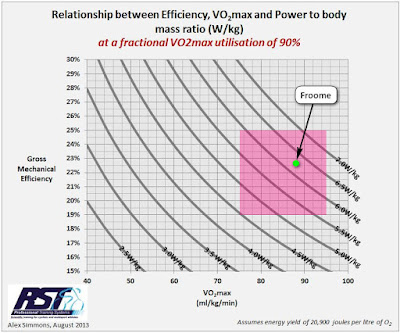A little over two years ago I wrote about the relationship between four key underpinning physiological parameters that determine a rider's sustainable power output:
- VO2max
- Energy yield from aerobic metabolism
- Efficiency
- Fractional utilisation of VO2max at threshold
I don't propose to repeat myself, so go here to read that first if you'd like a more detailed explanation.
Data on some physiological testing by Chris Froome was released earlier today, so I thought I'd put a marker on one of the charts I posted in that earlier item to see where he sits.
I took the data from the cyclingnews article linked below:
http://www.cyclingnews.com/news/chris-froomes-physiological-test-data-released/
In it the key 2015 data are listed as:
Weight: Test: 69.9kg, TdF: 67kg
VO2max: Test: 84.6ml/kg/min, TdF weight adjusted: 88.2ml/kg/min
Threshold power (20-40 min): 419W
W/kg: 5.98W/kg, TdF weight adjusted: 6.25W/kg
So given we are talking 20+ minute power, a fractional utilisation of 90% of VO2max for an elite athlete is not unreasonable, so here's that particular chart, and overlayed on that is a pink box defining the area covering a range of VO2max from 75ml/kg/min to 95ml/kg/min and gross efficiency range from 19% to 25%. You'd expect elite cyclists to be somewhere in that range.
Froome's estimated TdF VO2max and 20+ minute power/mass are then shown by the green dot:
What can we infer from this?
Not a lot really, other than the data are in line with what you would expect for a rider with the performances of a grand tour winner. Certainly the physiological values are in line with historical data on plausible physiological parameters for elite aerobic endurance athletes.
As far as informing on doping status, as with power meter data and climbing power estimates, it tells us SFA. In any case I doubt it will change anyone's opinion either way.
Edit: here is a link to the lab report:
https://www.gskhpl.com/dyn/_assets/_pdfs/ChrisFroome-BodyCompositionandAerobicPhysiology.pdf




0 comments:
Post a Comment